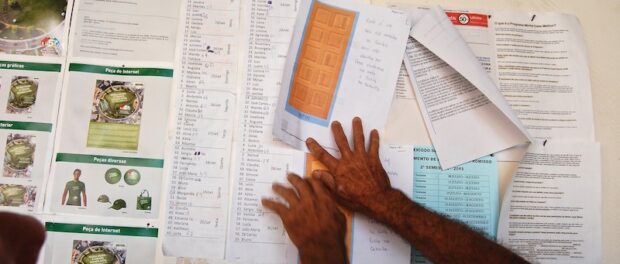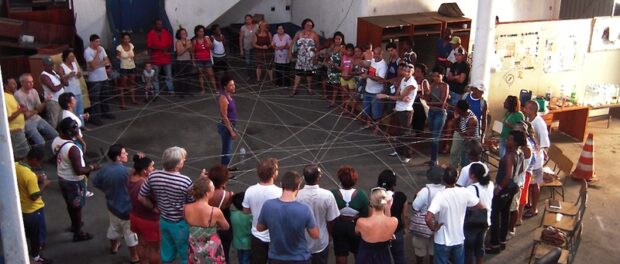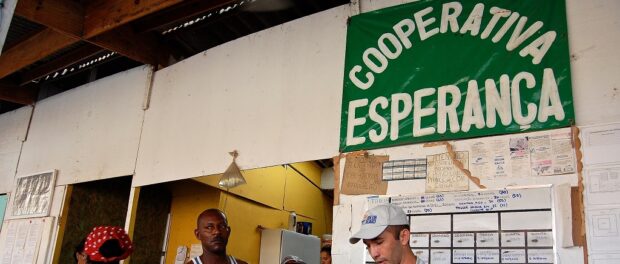
This is the third article in a four-part series on the potential to apply the Community Land Trust (CLT) model under existing Brazilian laws to secure land rights in Brazil’s favelas. The series was written for a Brazilian audience and summarizes and adapts a report by lawyer and urban planner Tarcyla Fidalgo, prepared with the support of the Lincoln Institute of Land Policy (LILP). It clarifies several aspects of the proposal, showing the foundations of the CLT model; adapting the model to favelas; and explaining its benefits, applicability, and ways of functioning. In this third article, we show how a Community Land Trust in Brazilian favelas could be created under current legislation, identifying possibilities among the various forms of creating a legal entity.
The publication of this series follows five days of workshops (from August 23-27) with a delegation from Puerto Rico, whose members successfully implemented a CLT in eight informal settlements along the Caño Martín Peña in San Juan with excellent results. The workshops were carried out by Catalytic Communities* in partnership with the Rio de Janeiro State Public Defender’s Office, Pastoral de Favelas, the Architecture and Urbanism Council of Rio de Janeiro (CAU/RJ), and the Laboratory for Studies of Transformations in Brazilian Urban Law (LEDUB).
Formalizing a CLT: Creating a Legal Entity
In order to create a Community Land Trust, it is necessary to have an institutional arrangement that allows for collective land ownership. For this reason, the best way to achieve this objective within existing Brazilian legislation is creating a legal entity—that is, an abstract entity, to which the law attributes legal personality, recognized as a subject of the law.
It is necessary to highlight that the legal entity is not a person per se (an individual), but rather an entity constituted by a group of people or assets that hold rights and duties. Legal entities can fall within the domain of public or private law, but in the case of a Favela CLT, it would be necessary to create a legal entity via the latter option since this is the format of associations, foundations, and organizations, among other relevant arrangements.
Freedom of association is established in the Constitution of 1998 and is also included among citizenship rights provided for in international human rights treaties. These institutions and organizations formed by civil society are part of the democratic exercise of citizenship by citizens. By means of these associative forms, the CLT model could be made viable.
Civil Society Organizations (CSOs) are characterized by their nonprofit nature, by their legal and voluntary creation and administration, and by the many legal formats that they can assume (such as cooperatives, associations, foundations, and religious organizations). Despite being nonprofits, CSOs can carry out income-generating activities, so long as these activities are coherent with their objectives.
To create a Community Land Trust, the legal entity to be created could be organized under some predetermined format of a Civil Society Organization: an association, a foundation, or a cooperative. However, the framework of a CLT’s objectives also allows for the creation of a legal entity based on other forms of social organization or management of assets and common projects, such as a consortium or condominium. Each of these options has its limits and possibilities. Therefore, the choice of format for creating a legal entity to initiate a CLT must take into account which of these options best fits the local context, demands, and needs.
Associations and Foundations
These are the most traditional formats that Civil Society Organizations assume. Associations are formed by the union of people who organize themselves for common and specific ends, which can be oriented towards the collective (e.g. associations for the defense of human rights or the environment); for mutual benefit; or restricted to a select and homogeneous group of members (e.g. a club). In the case of foundations, the founder must make an allocation of assets to create the foundation by public deed or will.
The main hindrance to starting a CLT as a foundation is this need for assets, so it is unlikely that a CLT in favelas will be capable of meeting this requirement at inception. That said, in management terms, a foundation offers a format that is better suited to the principles of Community Land Trusts. This is because as a foundation, management cannot change the intended purpose of assets since they are fixed and immutable, guaranteeing the continuity of the CLT’s principles. Associations, on the other hand, can manage the CLT’s assets and therefore its continuity will depend on the board’s continuing commitment to the CLT model.
Given the limitations of each format, one option could be to combine the two—initially creating an association (which does not require prior assets) and after acquiring land, creating a foundation (which guarantees that the assets are fixed and immutable).
Cooperatives
Cooperatives are regulated by Law 5.764 of December 16, 1971, which defines the National Policy on Cooperatives. This law defines cooperatives as societies of people with their own form, legal nature, and characteristics. Cooperatives can assume diverse formats: primary cooperatives, central cooperatives, federations of cooperatives, or confederations of cooperatives. However, a minimum of twenty individuals is necessary to form a cooperative.
This type of organization is established by members of a determined economic or social group with the objective of carrying out an activity for their common benefit. The basic premises of cooperativism are: (1) the identity of purposes and interests; (2) joint, voluntary, and objective action for the coordination of contribution and services; and (3) the achievement of useful and common results for all members of the cooperative.
The legal requirements for forming a cooperative are similar to the procedures for forming other types of legal entities. However, cooperatives are limited in their suitability for a CLT as their designated activity must be of economic nature with equal distribution of possible income or assets among members. Furthermore, there is a minimum number of members required to form a cooperative. The greatest limitation is the requirement that profits are developed and shared by its members, since CLTs are not commercial entities. However, one possibility could be to create a CLT in another format and later form a cooperative to manage the CLT. In this case, the two types could be combined in the form of a foundation managed through a cooperative, for example.
Consortia
A consortium is formed as a group based on the union of natural persons (individuals) and legal entities with the purpose of providing access to the consumption of assets and services through self-financing. This form of organization can be used for the acquisition of personal property, real estate, or by the group. To form an organization for the acquisition of assets, the consortium has a fixed term (which can be for an extended period of time).
This group is represented by its administrator and requires a consortium contract which participants sign to ensure that all participants fulfill their share of obligations. In the case of a CLT, the consortium could be intended for real estate acquisition, and the consortium contract could establish the possibilities for managing the CLT.
Condominiums
Finally, in the case of considering a CLT in the format of a condominium, two or more owners must exercise ownership over a determined property. Brazilian legislation provides for three types of condominiums: voluntary, necessary, and multi-owner or multi-use. In the case of a Community Land Trust, the most appropriate format suited to collective management would be the “condominium of lots” as established by Law 13.465 of July 11, 2017, which involves a voluntary condominium model.
In this format, a lot is considered an autonomous unit within the condominium and may or may not have buildings (which would also be part of the condominium). In this way, parts of the condominium can be for the exclusive use of building owners. Furthermore, a multi-ownership or multi-use condominium can be created within these areas included in the condominium of lots. At the same time, the lot itself would comprise the condominium of lots, which is subject to collective management under the ownership of the CLT. Therefore, to make use of a condominium, the land must be the property of the legal entity of the CLT and not of each individual owner. In this way, the CLT’s continuity and [residents’] tenure security are guaranteed.
In this case, structures situated within the CLT—but not the CLT itself—could be managed in the format of a condominium. Therefore, the CLT could be created under the category of a condominium of lots, but its management should be structured under another format (such as through a cooperative).
This is the third article in a four-part series.
*RioOnWatch is a project of the NGO Catalytic Communities


